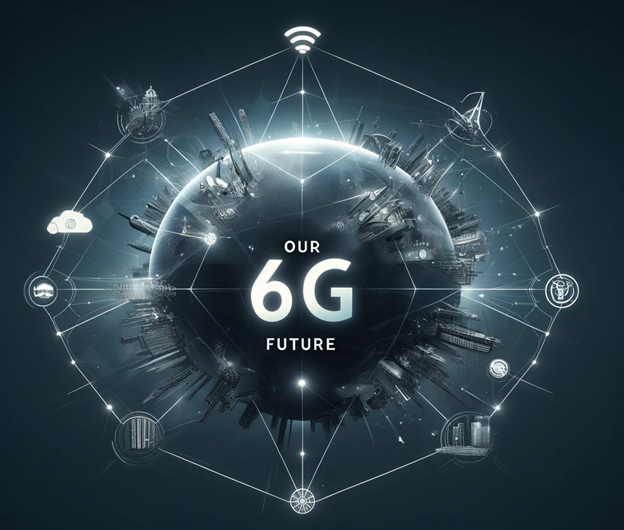The relentless march of technology has seen wireless communication evolve at an exponential pace. From the brick-sized phones and scratchy calls of 1G to the ubiquitous smartphones and blazing-fast internet of 5G.
Each generation has revolutionized the way we connect. But as our reliance on data and interconnectedness grows, so does the need for a more robust and versatile wireless infrastructure.
Enter 6G technology, the next frontier in mobile connectivity, promising to redefine how we experience the world around us.
This article delves into the exciting realm of 6G technology. We’ll explore its core functionalities, groundbreaking applications, and the profound impact it will have on various industries. We’ll also address the challenges that lie ahead, and the collaborative efforts required to usher in this next wave of connectivity.
Setting the Stage for 6G: Building on the Legacy of 5G
The rollout of 5G in recent years has significantly enhanced mobile broadband speeds and network capacity. With download speeds exceeding 1 Gigbibit per second (Gbps), 5G has enabled activities like high-definition video streaming and video conferencing on the go.
However, the ever-growing number of connected devices – from smartphones and laptops to smart appliances and wearables – coupled with the rise of data-intensive applications like virtual reality and augmented reality, necessitates a more powerful and adaptable wireless infrastructure.
6G technology builds upon the foundation laid by 5G, aiming to deliver significantly faster data transfer rates, ultra-low latency, and massive network capacity. It promises to be a transformative force, shaping not just how we use mobile devices but also fundamentally altering how industries operate and societies function.
Here’s a table summarizing the key differences between 5G and 6G technology:
| Feature | 5G | 6G |
| Peak Download Speeds | 1 Gbps to 10 Gbps | Up to 1 Terabyte per second (Tbps) |
| Latency | 1 to 10 milliseconds (ms) | Less than 1 millisecond (ms) |
| Network Capacity | Supports millions of devices per square km | Supports billions of devices per square km |
The scope of this article explores the technical aspects of 6G, its game-changing applications, the challenges that need to be overcome, and the anticipated timeline for its rollout.
Demystifying 6G Technology: Beyond Speed
6G technology represents a significant leap forward from its predecessor. Here’s a closer look at what sets it apart:
- Unprecedented Speeds: One of the most talked-about aspects of 6G is its phenomenal speed. While 5G boasts impressive gigabit-per-second (Gbps) data rates, 6G promises to reach theoretical speeds exceeding one terabyte per second (Tbps).Imagine downloading a high-definition movie in a fraction of a second! This will revolutionize content consumption, data transfer, and real-time applications like remote surgery and autonomous vehicles.
- Spectrum Exploration: To achieve these mind-boggling speeds, 6G will likely explore higher frequency bands, including the terahertz (THz) spectrum. This band offers immense potential for wider bandwidths, but it also comes with challenges.Signal propagation over these frequencies is more susceptible to attenuation, meaning shorter ranges and the need for denser network infrastructure. Researchers are actively developing solutions to overcome these limitations.
- The Power of AI: Artificial intelligence (AI) will be a cornerstone of 6G technology. AI algorithms will play a crucial role in network management, optimizing resource allocation, self-healing capabilities, and even real-time network reconfiguration based on traffic demands. This ensures a seamless and adaptive network experience for users.
Unveiling the Transformative Applications of 6G Technology
The phenomenal speed, ultra-low latency, and massive network capacity of 6G technology pave the way for a plethora of groundbreaking applications across various sectors. Here’s a glimpse into how 6G will revolutionize different aspects of our lives:
- Enhanced Mobile Broadband (eMBB): Redefining the Mobile Experience
With 6G’s exponentially faster speeds, mobile internet usage will transcend current limitations. Imagine seamless streaming of 8K or even 16K resolution content without buffering, lag-free video conferencing with lifelike clarity, and immersive virtual reality (VR) and augmented reality (AR) experiences – all accessible on the go.
6G will empower mobile devices to become even more powerful entertainment and productivity hubs. Imagine downloading a complex virtual reality game in seconds or collaborating on 3D design projects in real-time using AR headsets. The possibilities for entertainment, education, and remote work are truly limitless.
Unlock the future of connectivity
Prepare your apps for 6G’s ultra-fast, seamless performance with Neuronimbus
Discover More
- Ultra-Reliable Low-Latency Communications (URLLC): The Rise of the Real-Time World
6G’s ultra-low latency will usher in an era of real-time communication and control. This has profound implications for several critical applications:
- Autonomous Vehicles: 6G’s near-instantaneous responsiveness will be essential for the safe and efficient operation of autonomous vehicles. Real-time data exchange between vehicles, surrounding infrastructure, and traffic management systems will be crucial for collision avoidance, navigation, and dynamic route optimization.
- Telemedicine: 6G will enable remote surgery with minimal lag, allowing surgeons to operate on patients located far away. This has the potential to revolutionize healthcare delivery, especially in remote areas where access to specialists might be limited. Imagine a scenario where a surgeon in a major city can perform a life-saving procedure on a patient in a rural area, with minimal risk of complications due to latency.
- Industrial Automation: 6G’s reliability and low latency will empower the deployment of advanced robotics in manufacturing facilities. Machines will be able to communicate and react in real-time, optimizing production processes, ensuring safety, and enabling predictive maintenance to prevent downtime.
- Massive Machine-Type Communications (mMTC): Powering the Immense Internet of Things (IoT)
The Internet of Things (IoT) is poised for explosive growth, with billions of devices connecting to the internet. Smartphones, wearables, sensors in homes and cities, and industrial machines will all generate vast amounts of data. 6G’s massive network capacity will be essential to accommodate this surge in connected devices.
Efficient data transfer and seamless device interaction will be crucial for the smooth operation of smart cities, environmental monitoring systems, and interconnected transportation networks.
These are just a few examples of how 6G technology will transform various industries. In the next section, we’ll explore the far-reaching impact of 6G on different sectors of society.
Industry Implications of 6G Technology

The transformative potential of 6G extends far beyond enhanced mobile broadband. Here’s a glimpse into how different industries will be impacted:
- Telecommunications: Telecom operators will need to invest in upgrading infrastructure to support 6G’s higher frequencies and densify networks to address signal propagation challenges. New business models may emerge to monetize the capabilities of 6G, such as network slicing for specific applications or offering ultra-reliable low-latency services to critical industries.
- Manufacturing and Industry 4.0: 6G will accelerate the adoption of Industry 4.0 principles, with intelligent factories utilizing real-time data and AI-powered automation to optimize production processes and supply chains. Enhanced collaboration between robots and human workers will be facilitated by 6G’s low latency and reliability.
- Healthcare: Beyond remote surgery, 6G will enable remote patient monitoring, real-time data analysis for personalized medicine, and the widespread deployment of wearable health sensors for preventative care. The potential to improve healthcare outcomes and accessibility across geographical regions is significant.
- Transportation and Smart Cities: Connected vehicles utilizing 6G will transform traffic management, enabling real-time route optimization, accident prevention, and the development of autonomous transportation systems. Smart cities will benefit from 6G’s ability to connect a vast network of sensors and devices, facilitating data-driven decision-making for efficient energy management, waste disposal, and public safety initiatives.
- Software Development: 6G will significantly impact software development by enabling ultra-fast, low-latency networks that facilitate the creation of more dynamic and interactive applications. This allows for real-time data usage and cloud-based innovations, enhancing mobile and web application responsiveness.
The applications of 6G technology are truly far-reaching, with the potential to revolutionize every facet of our lives.
Challenges and the Road Ahead: Ushering in the Era of 6G
The path towards widespread 6G adoption is paved with both immense potential and significant challenges. Here’s a closer look at the hurdles that need to be overcome:
- Technical Hurdles: Operating in the terahertz (THz) band, a potential spectrum for 6G, presents technical difficulties. Signal attenuation over these frequencies is higher, necessitating denser network infrastructure with smaller cell sizes. Researchers are actively developing solutions like beamforming technologies to focus and strengthen signals.
- Security and Privacy Concerns: The hyper-connected nature of 6G networks raises critical security and privacy concerns. Securing vast amounts of data flowing through the network, protecting against cyberattacks, and ensuring user privacy will be paramount. Robust security protocols and ethical data governance practices will be essential.
- Standardization and Global Cooperation: Developing a global standard for 6G technology is crucial for seamless interoperability between networks and devices. Collaboration between governments, regulatory bodies, and telecom industries worldwide will be essential to ensure a smooth rollout and avoid fragmentation.
- Research and Innovation: Continuous research and development are needed to refine 6G technologies, address technical challenges, and explore new applications. Investment in research infrastructure and fostering a spirit of innovation will be critical for unlocking the full potential of 6G.
Timeline and Anticipated Rollout
While 6G is still in its early stages of development, industry experts predict a potential timeframe for its rollout:
- 2025-2030: Continued research and development, standardization efforts, and initial pilot projects.
- 2030-2035: Gradual commercial rollout of 6G networks in select regions.
- 2035 onwards: Wider adoption and integration of 6G technology across various industries and applications.
It’s important to note that these are estimations, and the actual timeline may vary depending on technological advancements and global cooperation.
Conclusion
6G technology promises to be a transformative force, ushering in an era of hyper-connectivity, ultra-fast data speeds, and real-time applications. From revolutionizing the way we experience mobile internet to enabling advancements in critical sectors like healthcare, transportation, and manufacturing, 6G has the potential to profoundly shape our world.
The challenges on the road to 6G adoption are significant, but the potential rewards are immense. By fostering collaboration, prioritizing security and innovation, and investing in research and development, we can unlock the transformative potential of 6G and create a future where connectivity empowers us to live, work, and interact in ways we can only begin to imagine.
Prepare for the future with Neuronimbus as your technology partner. As 6G technology approaches, we can help you explore its vast potential within your industry. Together, we’ll identify opportunities for enhanced efficiency, innovation in products and services, and transformative customer experiences. Engage with our team of experts to stay at the forefront of technological evolution, ensuring your business is perfectly poised for success in a hyper-connected world. Start today and let Neuronimbus guide your journey into the 6G era.




